Spatial and Temporal Clustering Analysis of Extreme Wave Events around the UK Coastline
Abstract
:1. Introduction
2. Data
3. Methodology
4. Results
4.1. Wave and Storm Event Identification
4.2. Spatial Footprint and Storm Track Analysis
4.3. Seasonality and Temporal Clustering Analysis
4.4. The Unusual 2013/14 Season
5. Discussion
6. Conclusions
Acknowledgments
Author Contributions
Conflicts of Interest
References
- Wolf, J.; Brown, J.; Howarth, M. The wave climate of Liverpool Bay—Observations and modelling. Ocean Dyn. 2011, 61, 639–655. [Google Scholar] [CrossRef]
- Tucker, M.J.; Pitt, E.G. Waves in Ocean Engineering; Elsevier: Amsterdam, The Netherlands, 2001; p. 521. [Google Scholar]
- Clément, A.; McCullen, P.; Falcão, A.; Fiorentino, A.; Gardner, F.; Hammarlund, K.; Lemonis, G.; Lewis, T.; Nielsen, K.; Petroncini, S.; et al. Wave energy in Europe: Current status and perspectives. Renew. Sustain. Energy Rev. 2002, 6, 405–431. [Google Scholar] [CrossRef]
- Wolf, J. Coupled wave and surge modelling and implications for coastal flooding. Adv. Geosci. 2008, 17, 19–22. [Google Scholar] [CrossRef]
- Jonkman, S.N.; Vrijling, J.K. Loss of life due to floods. J. Flood Risk Manag. 2008, 1, 43–56. [Google Scholar] [CrossRef]
- Wolf, J. Coastal flooding: Impacts of coupled wave-surge-tide models. Nat. Hazards 2008, 49, 241–260. [Google Scholar] [CrossRef]
- Hinton, C.; Townend, I.H.; Nicholls, R.J. Future Flooding and Coastal Erosion Risks; Thomas Telford: London, UK, 2007; Chapter 9; p. 514. [Google Scholar]
- Battjes, J.A.; Gerritsen, H. Coastal modelling for flood defence. Philos. Trans. R. Soc. Lond. A Math. Phys. Eng. Sci. 2002, 360, 1461–1475. [Google Scholar] [CrossRef] [PubMed]
- McInnes, K.L.; Hubbert, G.D.; Abbs, D.J.; Oliver, S.E. A numerical modelling study of coastal flooding. Meteorol. Atmos. Phys. 2002, 80, 217–233. [Google Scholar] [CrossRef]
- Lewis, M.; Horsburgh, K.; Bates, P.; Smith, R. Quantifying the uncertainty in future coastal flood risk estimates for the UK. J. Coast. Res. 2011, 27, 870–881. [Google Scholar] [CrossRef]
- Lewis, M.; Schumann, G.; Bates, P.; Horsburgh, K. Understanding the variability of an extreme storm tide along a coastline. Estuar. Coast. Shelf Sci. 2013, 123, 19–25. [Google Scholar] [CrossRef]
- Thorne, C. Geographies of UK flooding in 2013/4. Geogr. J. 2014, 180, 297–309. [Google Scholar] [CrossRef]
- Wadey, M.; Haigh, I.; Brown, J. A century of sea level data and the UK’s 2013/14 storm surges: An assessment of extremes and clustering using the Newlyn tide gauge record. Ocean Sci. Discuss. 2014, 11, 1995–2028. [Google Scholar] [CrossRef]
- Chailan, R.; Toulemonde, G.; Bouchette, F.; Laurent, A.; Sevault, F.; Michaud, H. Spatial Assessment of Extreme Significant Wave Heights in the Gulf of Lions. Int. Conf. Coast. Eng. 2014, 1, 17. [Google Scholar] [CrossRef]
- Haigh, I.D.; Wadey, M.P.; Wahl, T.; Ozsoy, O.; Nicholls, R.J.; Brown, J.M.; Horsburgh, K.; Goulby, B. Spatial Footprint and Temporal Clustering of Extreme Sea Level and Storm Surge Evens around the Coastline of the UK. Sci. Data 2016, 3, 160107. [Google Scholar] [CrossRef] [PubMed]
- Hall, J.W.; Tran, M.; Hickford, A.J.; Nicholls, R.J. (Eds.) The Future of National Infrastructure: A System-of-Systems Approach; Cambridge University Press: Cambridge, UK, 2016. [Google Scholar]
- Karunarathna, H.; Pender, D.; Ranasinghe, R.; Short, A.D.; Reeve, E. The effects of storm clustering on beach profile variability. Mar. Geol. 2014, 348, 103–112. [Google Scholar] [CrossRef]
- Ferreira, O. Storm groups versus extreme single storms: Predicted erosion and management consequences. J. Coast. Res. 2005, 42, 221–227. [Google Scholar]
- Mailier, P. Serial Clustering of Extratropical Cyclones. Ph.D. Thesis, Department of Meteorology, University of Reading, Reading, UK, June 2007. [Google Scholar]
- De la Vega-Leinert, A.; Nicholls, R. Potential Implications of Sea-Level Rise for Great Britain. J. Coast. Res. 2008, 242, 342–357. [Google Scholar] [CrossRef]
- Wadey, M.P.; Haigh, I.D.; Brown, J. A temporal and spatial assessment of extreme sea level events for the UK coast. In Proceedings of the International Short Conference on Advances in Extreme Value Analysis and Application to Natural Hazards (EVAN2013), Siegen, Germany, 18–20 September 2013. [Google Scholar]
- Cefas—WaveNet. Available online: http://www.cefas.co.uk/cefas-data-hub/wavenet/ (accessed on 14 July 2016).
- Hawkes, P.J.; Atkins, R.; Brampton, A.H.; Fortune, D.; Garbett, R.; Gouldby, B.P. WAVENET: Nearshore Wave Recording Network for England and Wales, Feasibility Study; HR Wallingford: Wallingford, UK, 2001. [Google Scholar]
- CCO Map Viewer & Data Search. Available online: http://www.channelcoast.org/ (accessed on 14 July 2016).
- Compo, G.P.; Whitaker, J.S.; Sardeshmukh, P.D.; Matsui, N.; Allan, R.J.; Yin, X.; Gleason, B.E.; Vose, R.S.; Rutledge, G.; Bessemoulin, P.; et al. The Twentieth Century Reanalysis Project. Q. J. R. Meteorol. Soc. 2001, 137, 1–28. [Google Scholar] [CrossRef]
- Kalnay, E.; Kanamitsu, M.; Kistler, R.; Collins, W.; Deaven, D.; Gandin, L.; Iredell, M.; Saha, S.; White, G.; Woollen, J.; et al. The NCEP/NCAR 40-Year Re analysis Project. Bull. Am. Meteorol. Soc. 1996, 77, 437–471. [Google Scholar] [CrossRef]
- Castelle, B.; Dodet, G.; Masselink, G.; Scott, T. A new climate index controlling winter wave activity along the Atlantic coast of Europe: The West Europe Pressure Anomaly. Geophys. Res. Lett. 2017, 44, 1384–1392. [Google Scholar] [CrossRef]
- Jones, P.D.; Jonsson, T.; Wheeler, D. Extension to the North Atlantic Oscillation using early instrumental pressure observations from Gibraltar and South-West Iceland. Int. J. Climatol. 1997, 17, 1433–1450. [Google Scholar] [CrossRef]
- NAO Data. Available online: https://crudata.uea.ac.uk/cru/data/nao/ (accessed on 18 June 2017).
- Climate Prediction Center—Monitoring & Data Index. Available online: http://www.cpc.ncep.noaa.gov/data/ (accessed on 18 June 2017).
- Paolo, C.; Coco, G. (Eds.) Coastal Storms: Processes and Impacts; John Wiley & Sons: Hoboken, NJ, USA, 2017. [Google Scholar]
- Bacon, S.; Carter, D. A connection between mean wave height and atmospheric pressure gradient in the North Atlantic. Int. J. Climatol. 1993, 13, 423–436. [Google Scholar] [CrossRef]
- Bauer, E. Inter-annual changes of the ocean wave variability in the North Atlantic and in the North Sea. Clim. Res. 2001, 18, 63–69. [Google Scholar] [CrossRef]
- Masselink, G.; Austin, M.; Scott, T.; Poate, T.; Russell, P. Role of wave forcing, storms and NAO in outer bar dynamics on a high-energy, macro-tidal beach. Geomorphology 2014, 226, 76–93. [Google Scholar] [CrossRef]
- Galanis, G.; Chu, P.; Kallos, G.; Kuo, Y.; Dodson, C. Wave height characteristics in the north Atlantic Ocean: A new approach based on statistical and geometrical techniques. Stoch. Environ. Res. Risk Assess. 2011, 26, 83–103. [Google Scholar] [CrossRef]
- Sibley, A.; Cox, D.; Titley, H. Coastal flooding in England and Wales from Atlantic and North Sea storms during the 2013/2014 winter. Weather 2015, 70, 62–70. [Google Scholar] [CrossRef]
- Nissen, K.; Leckebusch, G.; Pinto, J.; Renggli, D.; Ulbrich, S.; Ulbrich, U. Cyclones causing wind storms in the Mediterranean: Characteristics, trends and links to large-scale patterns. Nat. Hazards Earth Syst. Sci. 2010, 10, 1379–1391. [Google Scholar] [CrossRef]
- Woolf, D.K.; Challenor, P.G.; Cotton, P.D. Variability and predictability of the North Atlantic wave climate. J. Geophys. Res. 2002, 107, 3145. [Google Scholar] [CrossRef]
- Van Nieuwkoop, J.; Smith, H.; Smith, G.; Johanning, L. Wave resource assessment along the Cornish coast (UK) from a 23-year hindcast dataset validated against buoy measurements. Renew. Energy 2013, 58, 1–14. [Google Scholar] [CrossRef]
- Venugopal, V.; Nemalidinne, R. Wave resource assessment for Scottish waters using a large scale North Atlantic spectral wave model. Renew. Energy 2015, 76, 503–525. [Google Scholar] [CrossRef]
- Wolf, J.; Woolf, D.K. Storms and Waves. MCCIP Annual Report Card 2010–11; MCCIP Science Review: Suffolk, UK, 2010; p. 15. [Google Scholar]
- Masselink, G.; Castelle, B.; Scott, T.; Dodet, G.; Suanez, S.; Jackson, D.; Floc’h, F. Extreme wave activity during 2013/2014 winter and morphological impacts along the Atlantic coast of Europe. Geophys. Res. Lett. 2016, 43, 2135–2143. [Google Scholar] [CrossRef]
- Wiegel, R.L. Oceanographical Engineering; Courier Corporation: North Chelmsford, MA, USA, 2013. [Google Scholar]
- Young, I.R. Wind Generated Ocean Waves; Elsevier: Amsterdam, The Netherlands, 1999; Volume 2. [Google Scholar]
- Dodet, G.; Bertin, X.; Taborda, R. Wave climate variability in the North-East Atlantic Ocean over the last six decades. Ocean Model. 2010, 31, 120–131. [Google Scholar] [CrossRef]
- Wolf, J.; Woolf, D. Waves and climate change in the north-east Atlantic. Geophys. Res. Lett. 2006, 33, L06604. [Google Scholar] [CrossRef]
- Lowe, J.A.; Howard, T.; Pardaens, A.; Tinker, J.; Holt, J.; Wakelin, S.; Milne, G.; Leak, J.; Wolf, J.; Horsburgh, K.; et al. UK Climate Projections Science Report: Marine and Coastal Projections; Met Office Hadley Centre: Exeter, UK, 2009. [Google Scholar]
- Mori, N.; Yasuda, T.; Mase, H.; Tom, T.; Oku, Y. Projection of Extreme Wave Climate Change under Global Warming. Hydrol. Res. Lett. 2010, 4, 15–19. [Google Scholar] [CrossRef]
- Gulev, S.; Hasse, L. Changes of wind waves in the North Atlantic over the last 30 years. Int. J. Climatol. 1999, 19, 1091–1117. [Google Scholar] [CrossRef]
- Sterl, A.; Caires, S. Climatology, variability and extrema of ocean waves: The Web-based KNMI/ERA-40 wave atlas. Int. J. Climatol. 2005, 25, 963–977. [Google Scholar] [CrossRef]
- Ozer, J.; Padilla-Hernández, R.; Monbaliu, J.; Alvarez Fanjul, E.; Carretero Albiach, J.; Osuna, P.; Yu, J.; Wolf, J. A coupling module for tides, surges and waves. Coast. Eng. 2000, 41, 95–124. [Google Scholar] [CrossRef]
- Bunya, S.; Dietrich, J.; Westerink, J.; Ebersole, B.; Smith, J.; Atkinson, J.; Jensen, R.; Resio, D.; Luettich, R.; Dawson, C.; et al. A High-Resolution Coupled Riverine Flow, Tide, Wind, Wind Wave, and Storm Surge Model for Southern Louisiana and Mississippi. Part I: Model Development and Validation. Mon. Weather Rev. 2010, 138, 345–377. [Google Scholar] [CrossRef]
- Jane, R.; Dalla Valle, L.; Simmonds, D.; Raby, A. A copula-based approach for the estimation of wave height records through spatial correlation. Coast. Eng. 2016, 117, 1–18. [Google Scholar] [CrossRef]

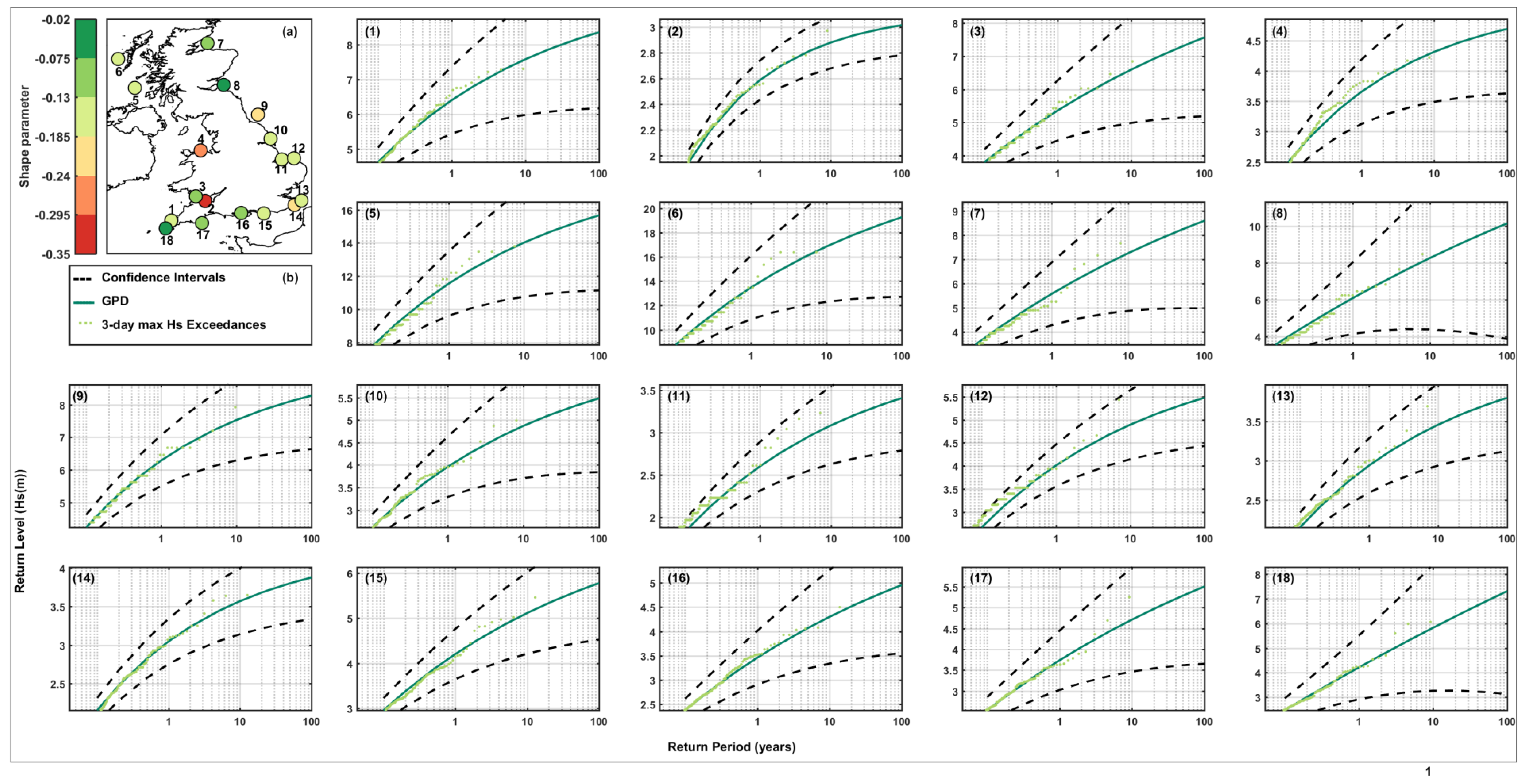
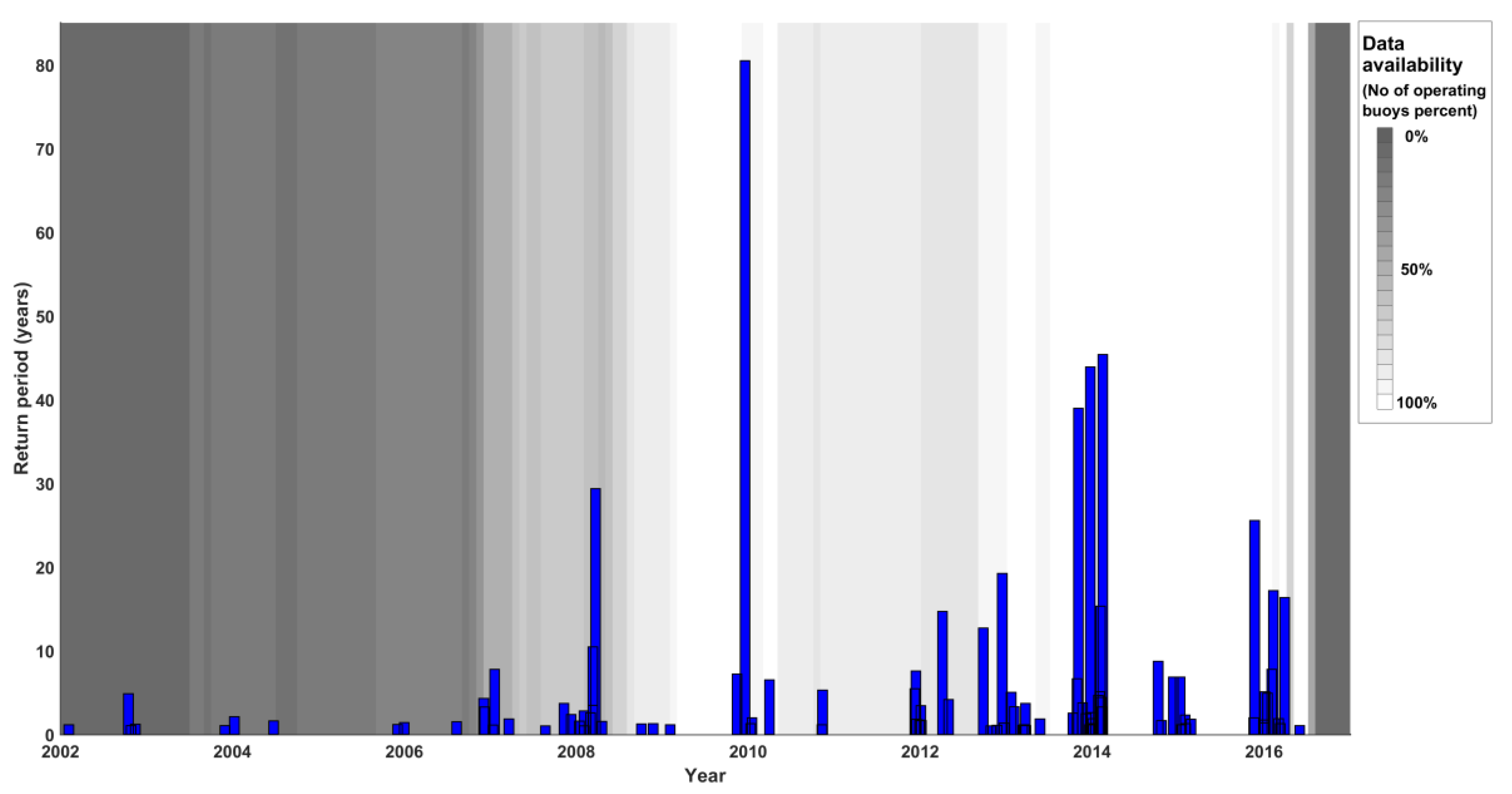


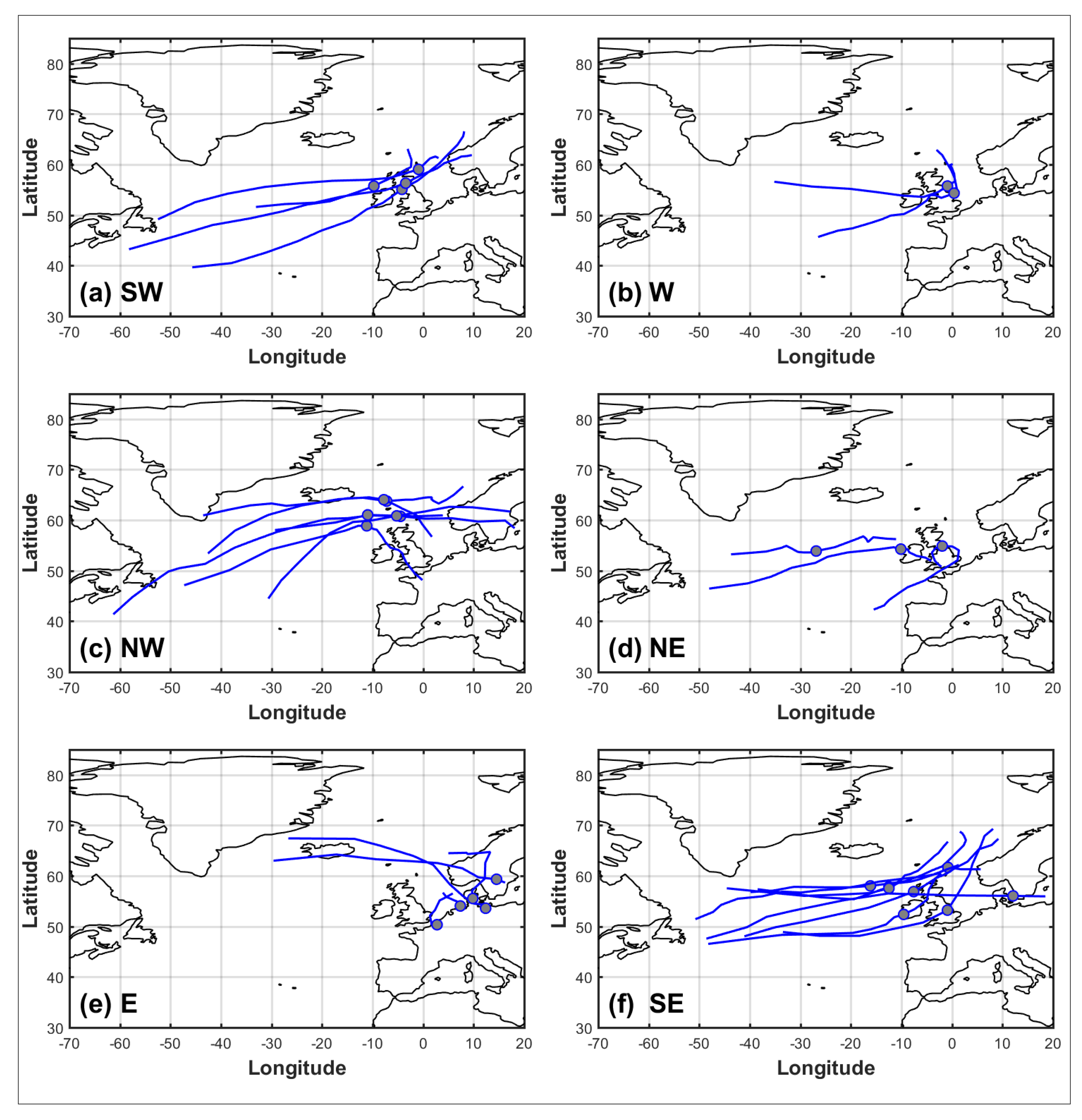
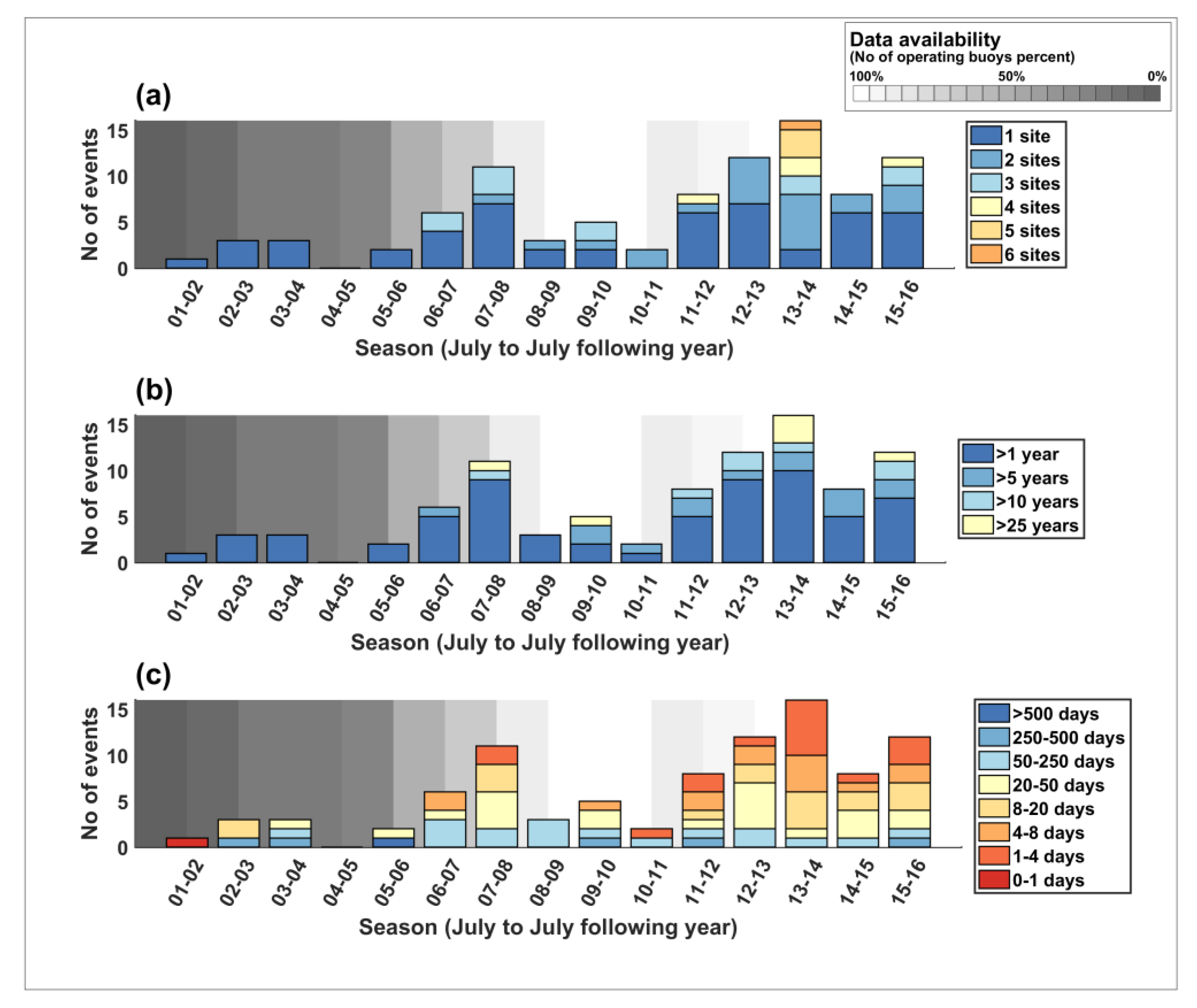
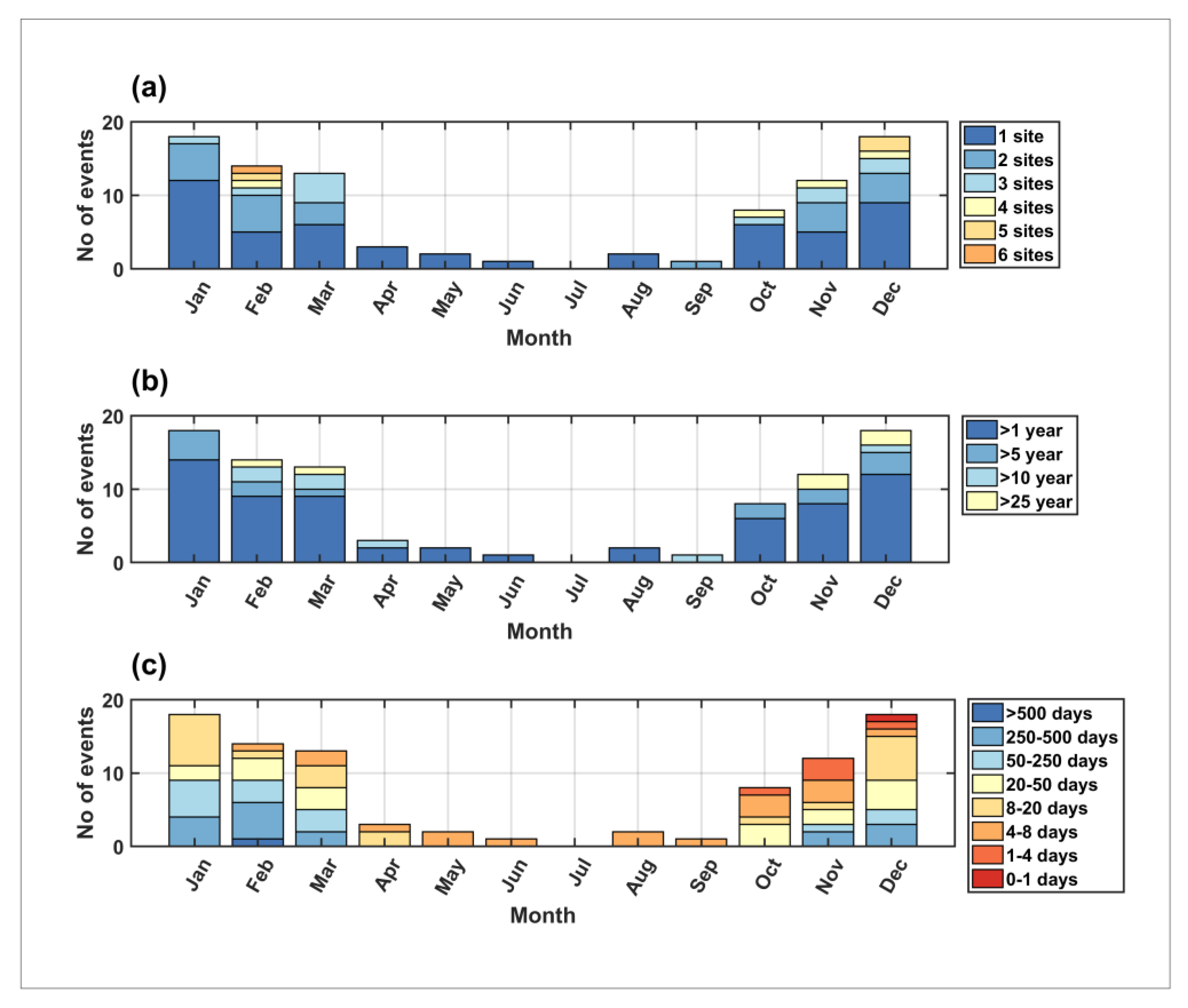

| Site Number | Site Name | Longitude (deg.) | Latitude (deg.) | Range | Number of Years (Data Range) | Depth (m CD) | Distance to Coast (km) |
|---|---|---|---|---|---|---|---|
| 1 | Perranporth | −5.188 | 50.403 | 2006–2016 | 9.1 (10.5) | 10 | 2.1 |
| 2 | Minehead | −3.449 | 51.235 | 2006–2016 | 8.7 (10.5) | 10 | 3.1 |
| 3 | Scarweather | −3.933 | 51.433 | 2005–2016 | 10.2 (11.9) | 35 | 14.7 |
| 4 | Rhyl Flats | −3.686 | 53.393 | 2007–2016 | 8.4 (10.2) | 10 | 9.5 |
| 5 | Blackstone | −7.062 | 56.062 | 2009–2016 | 7.3 (8.4) | 97 | 43.6 |
| 6 | West of Hebrides | −7.914 | 57.292 | 2009–2016 | 7.2 (8.4) | 100 | 29.6 |
| 7 | Moray Firth | −3.333 | 57.966 | 2008–2016 | 7.7 (8.9) | 54 | 26.9 |
| 8 | Firth of Forth | −2.504 | 56.188 | 2008–2016 | 7.8 (8.9) | 65 | 2.7 |
| 9 | Tyne/Tees | −0.749 | 54.919 | 2006–2016 | 9.5 (10.6) | 65 | 39.2 |
| 10 | Hornsea | −0.102 | 53.893 | 2008–2016 | 7.8 (9.1) | 12 | 2.95 |
| 11 | NorthWell | 0.475 | 53.008 | 2006–2016 | 6.8 (10.8) | 31 | 6.3 |
| 12 | Backney Overfalls | 1.104 | 53.058 | 2006–2016 | 6.9 (10.7) | 23 | 10.9 |
| 13 | Goodwin Sands | 1.483 | 51.252 | 2008–2016 | 6.8 (9) | 10 | 4.3 |
| 14 | Folkestone | 1.128 | 51.063 | 2003–2016 | 12.3 (14) | 13 | 0.79 |
| 15 | Rustington | −0.445 | 50.704 | 2003–2016 | 12.4 (14) | 9.9 | 8.8 |
| 16 | Milford | −1.604 | 50.721 | 2002–2016 | 13.1 (15.5) | 10 | 0.5 |
| 17 | Start Bay | −3.616 | 50.292 | 2007–2016 | 9 (10.2) | 10 | 1.5 |
| 18 | Penzance | −5.478 | 50.066 | 2007–2016 | 9 (10.2) | 10 | 5.4 |
| Site Number | Site Name | Return Period (Years) | |||||||||
|---|---|---|---|---|---|---|---|---|---|---|---|
| 0.5 | 1 | 2 | 5 | 10 | 20 | 25 | 50 | 75 | 100 | ||
| 1 | Perranporth | 5.94 | 6.40 | 6.81 | 7.27 | 7.57 | 7.84 | 7.92 | 8.15 | 8.27 | 8.35 |
| 2 | Minehead | 2.44 | 2.59 | 2.70 | 2.81 | 2.88 | 2.93 | 2.95 | 2.98 | 3.00 | 3.01 |
| 3 | Scarweather | 4.93 | 5.37 | 5.77 | 6.25 | 6.59 | 6.91 | 7.01 | 7.30 | 7.46 | 7.57 |
| 4 | Rhyl Flats | 3.37 | 3.65 | 3.89 | 4.15 | 4.32 | 4.45 | 4.49 | 4.60 | 4.66 | 4.69 |
| 5 | Blackstone | 10.61 | 11.57 | 12.41 | 13.39 | 14.02 | 14.59 | 14.76 | 15.24 | 15.49 | 15.66 |
| 6 | West of Hebrides | 12.24 | 13.49 | 14.63 | 15.97 | 16.87 | 17.68 | 17.93 | 18.64 | 19.02 | 19.28 |
| 7 | Moray Firth | 4.99 | 5.57 | 6.12 | 6.78 | 7.25 | 7.69 | 7.82 | 8.22 | 8.44 | 8.59 |
| 8 | Firth ofForth | 5.37 | 6.09 | 6.78 | 7.65 | 8.27 | 8.87 | 9.06 | 9.62 | 9.94 | 10.16 |
| 9 | Tyne/Tees | 5.78 | 6.29 | 6.73 | 7.22 | 7.53 | 7.79 | 7.87 | 8.09 | 8.20 | 8.27 |
| 10 | Hornsea | 3.61 | 3.96 | 4.28 | 4.64 | 4.87 | 5.08 | 5.15 | 5.33 | 5.42 | 5.48 |
| 11 | NorthWell | 2.42 | 2.60 | 2.77 | 2.96 | 3.08 | 3.19 | 3.23 | 3.32 | 3.37 | 3.40 |
| 12 | Backney Overfalls | 3.67 | 4.01 | 4.32 | 4.67 | 4.89 | 5.09 | 5.15 | 5.32 | 5.41 | 5.47 |
| 13 | Goodwin Sands | 2.74 | 2.94 | 3.12 | 3.32 | 3.46 | 3.57 | 3.61 | 3.71 | 3.76 | 3.80 |
| 14 | Folkestone | 2.83 | 3.05 | 3.24 | 3.44 | 3.57 | 3.68 | 3.71 | 3.80 | 3.85 | 3.88 |
| 15 | Rustington | 3.87 | 4.20 | 4.51 | 4.87 | 5.12 | 5.34 | 5.40 | 5.60 | 5.71 | 5.78 |
| 16 | Milford | 3.16 | 3.46 | 3.73 | 4.07 | 4.30 | 4.52 | 4.58 | 4.78 | 4.88 | 4.96 |
| 17 | Start Bay | 3.40 | 3.74 | 4.05 | 4.44 | 4.71 | 4.97 | 5.05 | 5.28 | 5.42 | 5.51 |
| 18 | Penzance | 3.70 | 4.21 | 4.71 | 5.35 | 5.82 | 6.28 | 6.43 | 6.87 | 7.13 | 7.31 |
| Site Number | NAO | EA | SCAND | WEPA | ||||
|---|---|---|---|---|---|---|---|---|
| Kendall’s Tau | p-Value | Kendall’s Tau | p-Value | Kendall’s Tau | p-Value | Kendall’s Tau | p-Value | |
| 1 | 0.57 | 0.03 | 0.26 | 0.34 | −0.31 | 0.26 | 0.39 | 0.14 |
| 2 | 0.48 | 0.08 | 0.34 | 0.22 | −0.02 | 1.00 | 0.34 | 0.22 |
| 3 | 0.32 | 0.21 | 0.54 | 0.03 | −0.47 | 0.06 | 0.51 | 0.04 |
| 4 | 0.00 | 1.00 | 0.16 | 0.63 | −0.11 | 0.77 | 0.16 | 0.63 |
| 5 | 0.83 | 0.00 | 0.04 | 1.00 | −0.12 | 0.80 | 0.20 | 0.62 |
| 6 | 0.56 | 0.10 | 0.22 | 0.60 | −0.22 | 0.60 | 0.30 | 0.43 |
| 7 | 0.00 | 1.00 | 0.30 | 0.40 | −0.15 | 0.72 | 0.30 | 0.40 |
| 8 | −0.61 | 0.04 | 0.07 | 0.91 | 0.20 | 0.58 | 0.00 | 1.00 |
| 9 | 0.02 | 1.00 | 0.11 | 0.74 | −0.37 | 0.18 | 0.32 | 0.24 |
| 10 | −0.39 | 0.22 | −0.13 | 0.74 | 0.85 | 0.00 | −0.07 | 0.91 |
| 11 | 0.08 | 0.85 | 0.60 | 0.04 | −0.18 | 0.57 | 0.75 | 0.01 |
| 12 | 0.03 | 1.00 | 0.55 | 0.06 | −0.14 | 0.68 | 0.49 | 0.10 |
| 13 | 0.68 | 0.04 | 0.37 | 0.36 | 0.05 | 1.00 | 0.26 | 0.54 |
| 14 | 0.39 | 0.08 | 0.21 | 0.37 | −0.21 | 0.37 | 0.30 | 0.19 |
| 15 | 0.55 | 0.02 | 0.33 | 0.17 | −0.17 | 0.49 | 0.40 | 0.10 |
| 16 | 0.28 | 0.20 | 0.46 | 0.03 | 0.08 | 0.75 | 0.37 | 0.09 |
| 17 | 0.42 | 0.16 | 0.14 | 0.69 | 0.08 | 0.84 | 0.53 | 0.07 |
| 18 | −0.08 | 0.85 | 0.39 | 0.17 | 0.23 | 0.44 | 0.54 | 0.05 |
| All sites | 0.36 | 0.07 | 0.36 | 0.07 | 0.05 | 0.84 | 0.70 | 0.00 |
| Site Number | Site Name | Mean Hs (m) | H0 (m) | Mean Tz (s) | Mean Tp (s) | Max Hs (m) | Max Return Period (years) | Date of Max Return Period |
|---|---|---|---|---|---|---|---|---|
| 1 | Perranporth | 1.56 | 1.71 | 5.81 | 10.47 | 7.3 | 5.30 | 8 February 2016 06:30 |
| 2 | Minehead | 0.56 | 0.58 | 3.99 | 6.51 | 2.97 | 38.96 | 2 November 2013 20:00 |
| 3 | Scarweather | 1.24 | 1.24 | 4.85 | 8.73 | 6.84 | 17.20 | 8 February 2016 15:00 |
| 4 | Rhyl Flats | 0.69 | 0.69 | 3.21 | 4.29 | 4.22 | 6.53 | 31 March 2010 10:00 |
| 5 | Blackstone | 2.59 | 2.59 | 6.38 | 10.64 | 13.8 | 7.78 | 1 February 2016 21:30 |
| 6 | West of Hebrides | 2.94 | 2.94 | 6.73 | 11.00 | 16.39 | 6.85 | 1 February 2016 18:30 |
| 7 | Moray Firth | 1.10 | 1.10 | 4.21 | 7.21 | 7.66 | 19.24 | 15 December 2012 01:30 |
| 8 | Firth of Forth | 1.04 | 1.04 | 4.27 | 6.87 | 8.48 | 12.73 | 25 September 2012 08:00 |
| 9 | Tyne/Tees | 1.34 | 1.34 | 4.64 | 7.47 | 7.92 | 29.37 | 22 March 2008 02:30 |
| 10 | Hornsea | 0.83 | 0.84 | 4.10 | 7.24 | 4.99 | 14.72 | 4 April 2012 04:30 |
| 11 | NorthWell | 0.64 | 0.64 | 3.35 | 4.50 | 3.23 | 25.57 | 21 November 2015 08:30 |
| 12 | Backney Overfalls | 0.92 | 0.92 | 3.87 | 5.99 | 5.43 | 80.51 | 17 December 2009 20:00 |
| 13 | Goodwin Sands | 0.67 | 0.67 | 3.57 | 5.21 | 3.69 | 43.89 | 24 December 2013 02:30 |
| 14 | Folkestone | 0.58 | 0.58 | 3.55 | 5.19 | 3.65 | 16.35 | 28 March 2016 04:30 |
| 15 | Rustington | 0.82 | 0.84 | 3.77 | 6.44 | 5.46 | 30.47 | 24 December 2013 02:30 |
| 16 | Milford | 0.64 | 0.67 | 4.19 | 8.18 | 4.5 | 19.06 | 14 February 2014 22:30 |
| 17 | Start Bay | 0.70 | 0.73 | 4.39 | 8.07 | 5.25 | 45.40 | 14 February 2014 21:30 |
| 18 | Penzance | 0.64 | 0.67 | 4.43 | 8.62 | 6.06 | 14.43 | 4 February 2014 19:00 |
© 2017 by the authors. Licensee MDPI, Basel, Switzerland. This article is an open access article distributed under the terms and conditions of the Creative Commons Attribution (CC BY) license (http://creativecommons.org/licenses/by/4.0/).
Share and Cite
Malagon Santos, V.; Haigh, I.D.; Wahl, T. Spatial and Temporal Clustering Analysis of Extreme Wave Events around the UK Coastline. J. Mar. Sci. Eng. 2017, 5, 28. https://doi.org/10.3390/jmse5030028
Malagon Santos V, Haigh ID, Wahl T. Spatial and Temporal Clustering Analysis of Extreme Wave Events around the UK Coastline. Journal of Marine Science and Engineering. 2017; 5(3):28. https://doi.org/10.3390/jmse5030028
Chicago/Turabian StyleMalagon Santos, Victor, Ivan D. Haigh, and Thomas Wahl. 2017. "Spatial and Temporal Clustering Analysis of Extreme Wave Events around the UK Coastline" Journal of Marine Science and Engineering 5, no. 3: 28. https://doi.org/10.3390/jmse5030028




